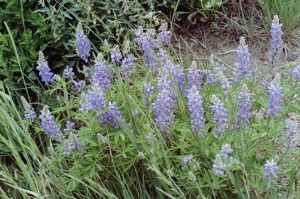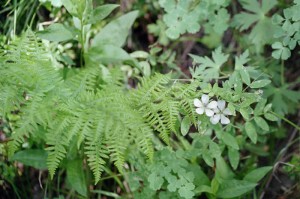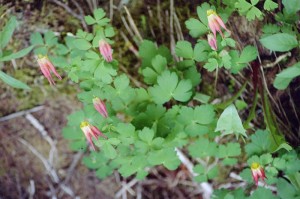Sometimes a person has to be surrounded by beauty to settle the soul. The best way to do that is to head to Marble during the wildflower season. From the valley floors where the creeks feed into the gorgeous Crystal River to the high montanes where the tundra is fed by snowmelt and thundershowers, Marble is blanketed with wildflowers during the summer.
Blossoms start to emerge in mid-June and last through September, though the peak of the wildflower season is generally acknowledged to be the third week in July. On north-facing slopes on the valley floor, where the shady trees provide protection from the harsh sun, coneflowers and fireweed grow tall. Coneflowers grow chest high and boast yellow blossoms that look somewhat like a sunflower, but the center seed cone is very tall and yellow instead of brown. Butterflies love it. Fireweed is easily distinguished by its fuchsia blossoms radiating around a tall stem, and it’s usually found in areas that have been disturbed or burned off, such as a forest fire. In the Marble area, fireweed is common along creek banks.
In the many aspen groves around Marble, particularly where the trees are tall and lush, you’ll find many large patches of cow parsnip. It’s an unlovely name for a lovely plant. Cow parsnip grows as tall as six feet, and has a hollow stem and dinner-plate-sized deep green leaves. The flowers grow up tall above the rest of the plant, and are a soup bowl-sized collection of tiny white blossoms. Later in the summer the blossoms form into seeds that disperse several feet from the mother plant when touched by a passing elk, deer, or hiker. The aspen groves in Lead King Basin, Yule Creek, and Lost Trail Creek are some of the best places to see cow parsnip.
The “rock stars” of the wildflowers are found at higher elevations, and no place is better to view them than Lead King Basin. The mountainsides of Lead King Basin are home to an explosion of wildflowers every summer. Viewing is best in those summers following a winter of good snowfall. Summer 2004 should be outstanding. Typically the best week is the third week in July, when the mountainsides are a riot of pale blue, purple, yellow, lavender, rose, white, and red. The species in Lead King Basin are almost too many to mention—there are almost 20 species of sunflowers alone. However, some of the standouts are:
- Foxfire, with its delicate bell-shaped bright red blossoms
- Giant larkspur, which is a gorgeous purple-headed flower growing to over four feet tall
- Blue flax, with slender stems and pale blue flowers that close up every night
- Columbine, the state flower of Colorado, known by a cluster of flowers with small white petals alternated by large petals of blue, lavender, red, or purple
- Indian paintbrush, a red brush of petals
- Showy daisy, a purple daisy with a yellow center, which can tolerate warmer south-facing hillsides
- Sunflowers, which come in dozens of colors and sizes
At elevations above timberline, flowers are generally smaller and have a lower profile, but sometimes the color of the flowers is more intense. On high-elevation hikes, look for pink elephants and rosy paintbrush.
Other good locations in the Marble area involve hiking to see the flowers. Lost Trail Creek, Yule Creek, North Anthracite, Carbonate Creek, and Hasley Basin are also terrific locations for wildflower viewing.
Please remember that wildflowers spread their seeds through their blossoms. Please don’t pick the wildflowers. It is against the law to pick wildflowers on Forest Service property. Your bouquet at home will quickly wilt and there will be fewer flowers next year. Secondly, when viewing flowers, don’t drive off the road, which is also illegal – see our 4×4 Rules of the Road.
If you want to pick something, you’re welcome to pick some of the wild berries that are commonly found in the Marble area. Just leave plenty for the bears, the grouse, and the songbirds. Most of the berries are ripe starting in late August through mid-September. All are good to eat, but some are better than others.
At lower elevations, particularly on south-facing slopes intermixed with aspens and oak brush, you’ll find chokecherries and serviceberries (pronounced in the West as “SARviceberry”). Both berries grow in bushes with stems between a half-inch and two inches in diameter. Chokecherries are so named because they have a bitter, mouth-puckering taste. The cherries are about 3/8-inch in diameter and have a good-sized stone. Old-time Westerners have made jelly, jam, and wine from the cherries for years, using lots of sugar to knock down the bitterness. Once your mouth gets used to the bitter taste, they’re tolerable to eat on the trail.
Serviceberries make for much better eating. At the peak of their ripeness, the berries are much like a blueberry in size and flavor and very juicy and tasty. If they’re past their peak, they can be pasty and somewhat flavorless. When they’re ripe, they’re great for pies, on ice cream, and in smoothies.
Be forewarned that chokecherries and serviceberries are favorites of bears. If the berries are there, it’s only a matter of time before the bears are, too. During the fall the bears will eat as much as 20 hours a day, so be fair and leave berries for the bears and also make noise and watch out for them as you’re picking.
Thimbleberries are another beautiful mountain berry. The plants are found at higher elevations, usually on well-watered steep slopes. The leaves are giant, and the thimbleberry has a pretty white blossom. The plants cluster together and grow 18”-24” tall. The fruit looks like a raspberry but is finer, with smaller seeds. It is a very delicate fruit and will crush easily in your fingertips. It is also very juicy and tasty.
Currants are found at high elevations (between 10,000 and 12,000 feet) on south-east to southwest facing slopes. They’re the wild version of Grandma’s gooseberries. The bushes are low, between 18” and 36” high, and the stems are covered with little stickers. The berries are round, bright red, and very sweet and juicy when ripe. If you’re picking them after the first hard freeze, you may taste a little alcohol in them. Blue grouse love these berries. It’s too much work to find enough berries to make a pie or dessert, but you can certainly find enough for a handful or two for a snack during a hike.
Raspberries are also found in the Marble area, but only in small numbers. They like rock slides and other new soils at middle and higher elevations.
When the blossoms start to drop off the wildflowers, the berries start to ripen. When the berries are gone, it’s time to hunt. When the hunting season is over, then it’s winter in Marble, and it’s time for a host of exciting winter activities.




